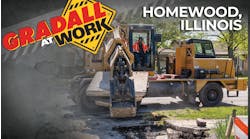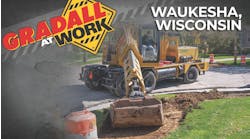Roadside construction is never the safest work place: inattentive drivers, tight working lanes, the challenge of moving materials and equipment alongside major highways. The Eastern North Carolina Natural Gas Project, a joint venture between Progress Energy and the Albemarle Pamlico Economic Development Corporation (APEC) is such an example. Starting in August 2001, the process of laying over 520 miles of transmission pipe and 250 miles of distribution pipe began, with 220 miles of the transmission pipe being laid roadside. The entire project is expected to last through December 2004.
Charged with the job of laying the entire 520 miles of transmission pipe is Patterson & Wilder, Wilmington, N.C., with offices in Newton Grove, N.C., Raleigh, N.C., and Birmingham, Ala. Well-versed in heavy equipment advances and the latest technologies, Patterson & Wilder took a chance and set aside, for the most part, its fleet of conventional excavators for near-zero tail swing models that provide more working space along the busy highways of North Carolina. Since work began on the project, the preconceptions and worries of operators who thought these excavators wouldn't perform as well as conventional models have been dismissed.
Inside the white line
George "Bronc" Pugh, Patterson & Wilder's vice president of construction, was working in the pipeline industry before many of his employees were even born. Beginning as a laborer on a ditch gang in 1958, Bronc has seen just about everything in his long career in pipeline construction. This marks the first time his crews have implemented the near-zero tail swing excavators on a project, a decision made with roadside safety and work performance in mind.
"When you're working on a two-lane highway, you can't have a piece of machinery cross the white line," said Bronc. "Our conventional excavator, when swinging around, would cross the white line. These new bobtails don't do that. So one of my foremen said he wanted one of these bobtail excavators, so I got him one. Another foreman said he didn't want one--so I got him two. He likes them now."
"Bobtail" is Bronc-talk for near-zero tail swing. The excavator Patterson & Wilder chose is Komatsu's PC228USLC-3, a model whose tail protrudes no more than 5.5 in. from the track. At most, this excavator occupies 13 ft 1 in. of road width, allowing for the machine to work on either side of a two-lane road without having to close both lanes. On a four-lane highway it allows for one lane to be shut down without impeding the next lane over, eliminating the need for a flagger as long as its tracks do not cross the white line.
All in a day's work
On a typical day, Patterson & Wilder's roadside crews can lay from 2,000 to 4,000 ft of 12-in. steel pipe (4,000 to 7,000 ft when working cross-country). The variation in production numbers stems from the uncertainty in daily obstacles such as utilities and terrain that requires directional drilling. The pipeline requires from 3 to 4 ft of cover, meaning that digging depths reach from 5 to 6 ft--not a problem for an excavator whose digging depth exceeds 20 ft. What naturally comes into question when someone first looks at an excavator like the zero-tail swing model is not its digging prowess, but its power and lifting abilities. One would assume that a machine without a profound rear-section would not have the same counterweight as conventional machines, making the machine unstable. In fact, the lack of physical space is made up with a heavier counterweight and a longer undercarriage that increases lift capacity and stability.
The PC228USLC's counterweight weighs 14,021 lb compared to 8,260 lb on the comparable conventional excavator and ensures stability when digging roadside trenches or lifting pipe into place. Stability is critical to Patterson & Wilder as they encounter both of these applications on a daily basis.
Patterson & Wilder foreman Harrell Defoe, like Bronc Pugh, has seen his share of construction equipment in 33 years with the company. To Defoe, these excavators pose "no problem at all" when lifting the 60-ft-long pieces of pipe into a trench, even on the slight decline of most highway roadsides.
Pipeline workhorses
Patterson & Wilder rents the near-zero tail swing excavators from Mitchell Distributing, a process that works well for Patterson & Wilder considering the nomadic and varying nature of its business. The stigma surrounding rental equipment and being able to judge a machine's long-term reliability doesn't apply here. Each unit has been on the job since December 2001 and will continue on until the focus of the Eastern North Carolina Gas Project turns to cross-country pipe in the summer of 2003.
As of February 2003, two of the excavators operated on site had readings of 2,076 and 1,942 hours. These machines are used constantly and have had no major problems to report, despite the varying work environments and conditions encountered. Bronc's crews put in 50- to 80-hour weeks and require reliability and consistent production out of their equipment.
"It won't take the operators or the foremen very long to tell me if a machine is garbage or not," said Bronc. "I haven't heard that about these machines."
A big part of ensuring productivity is equipment maintenance. The PC228USLC is typical of the concerted efforts by heavy equipment manufacturers to make machines easy to maintain. Engine-related maintenance items critical to a machine's operation (filters, reserve tanks, air cleaners) are all easily accessible through the engine hood. A hybrid filter design in the hydraulic circuit requires filter replacement to occur every 500 hours and extends hydraulic oil replacement intervals to 5,000 hours. A dust-proof radiator net prevents dust from entering into the radiator and causing engine overheating while a dual-filter air cleaner prevents dust from entering the engine. The features are all beneficial, not only in reducing maintenance time, but in keeping equipment running in the dirty, muggy conditions presented by roadside construction.
Just walk away
It's not that Bronc Pugh has prejudices against buying equipment, but when he knows that a project is destined to end in late 2004 or early 2005 and he currently has no idea where the next job will take him, renting equipment "as needed" makes sense. It lets contractors like Bronc tailor their equipment fleet to the job at hand, as Patterson & Wilder has done with its fleet of near-zero tail swing excavators.
"The biggest advantage to renting equipment is that you have the option to walk away from it," said Frank Dunn of Mitchell Distributing, longtime supplier to Patterson & Wilder. "These guys have this machine on a rental-purchase option, which gives them the best of both worlds. When a company pays it down, gets enough equity in it, it makes sense to convert it over to a purchase."
Out of their way
The greatest challenge to roadside construction may not have anything to do with cycle times but more to do with providing a safe environment for workers. This can be accomplished through minimal intrusion into the "real world"--the area that exists just over the white line where passersby don't always have the safety of roadside workers in mind. Now that companies are producing excavators that take up less space and provide comparable production rates to conventional excavators, it makes sense to utilize this type of equipment on roadside pipeline projects where a little extra space can greatly improve the safety of the work zone.
Since its creation in 1962, Patterson & Wilder has kept its employees not only through incentives and goodwill, but by keeping them safe and ensuring that everyone gets to work the next day. That commitment to safety is as much of a driver to productivity as any excavator and guarantees a final product that will be completed without incident and by going relatively unnoticed to the public.
"We get a lot of compliments on our work and our ability not to affect the normal flow of traffic," said Bronc. "We always put safety and environmental concerns first, then efficiency, and then however on down from there. Having equipment that accomplishes all of those helps."


